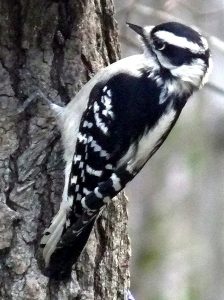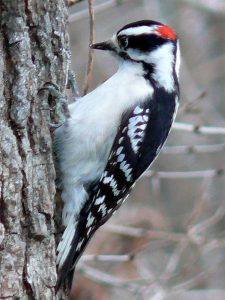Downy Woodpecker – Picoides pubescen
General
The Downy Woodpecker, Picoides pubescens, are the smallest and most common woodpecker of North America. Similar in appearance to the Hairy Woodpecker, Downy Woodpeckers can be distinguished by their diminutive size. Their stable and numerous populations offer frequent opportunities for backyard sightings, mixing advantageously with other bird flocks for protection and food sourcing. These agile foragers may be spotted among tree branches and tall brush or at a backyard feeder.
Description
Downy Woodpeckers are known for their bold black and white coloration, similar to that of the Hairy Woodpecker, and their small size. Their bodies, measuring 5.5”-6.5” in length and up to 1 oz. in weight, are a classic woodpecker shape, with a “straight, chisel-like bill, blocky head, wide shoulders, and straight-backed posture”1. Relative to their body size, the bill of the Downy seems small in comparison to the longer bill of the Hairy Woodpecker. The  wingspan ranges in size from 9.5” to 11.5”. The Downy has a white breast and black and white checkered wings and back, with a broad, white strip running down the center of the back. The head is striped in black and white. Males may be identified by the red patch on the nape of the neck., sometimes referred to as a cap. The outside tail feathers are predominantly white with some black markings present. The tail feathers are stiff and are used to brace the woodpecker’s body when boring holes.
wingspan ranges in size from 9.5” to 11.5”. The Downy has a white breast and black and white checkered wings and back, with a broad, white strip running down the center of the back. The head is striped in black and white. Males may be identified by the red patch on the nape of the neck., sometimes referred to as a cap. The outside tail feathers are predominantly white with some black markings present. The tail feathers are stiff and are used to brace the woodpecker’s body when boring holes.
Due to the expansive territory of this species, physical variations have developed. Seven subspecies of the Downy Woodpecker have been identified, differing mainly in size and also color. Birds living in northern environments typically grow largest, and western varieties are darker overall with less white on the wings. Downy Woodpeckers of the southeast may be identified by their smaller size and grayer undersides. Birds living along the Pacific coast typically display less white spotting on wing coverts and secondaries (a type of feather found on the wing,) while those living east of the Rockies have highly developed white spotting2. Downy Woodpeckers in the Pacific Northwest are known for their dusky coloration on the back and underside3.
Downy Woodpeckers, on average, live one to two years due to a high mortality rate in the first years of life. However, organizations have monitored birds in the wild living upwards of twelve years.
Behavior
The Downy Woodpecker exhibits a variety of behaviors that distinguish them as a unique species as well as identify them as a member of the greater woodpecker category. In flight, Downy Woodpeckers use an undulating flight pattern typical of many woodpecker species4, using a rhythm of quick wingbeats alternating with wings folding against the body. However, when moving along tree branches, Downy Woodpeckers swiftly move horizontally and downwards along branches with greater agility than other woodpecker species. As a defensive stance, a Downy Woodpecker will fan the tail feathers, and raise their head while jerking the bill back and forth. A courtship ritual consists of both males and females darting gracefully between trees, fluttering their wings softly in a butterfly-like display5.
Calls
Three distinct noises are associated with the Downy Woodpecker. The first, and probably most often associated with this species, is the drumming noise. A common misconception associated with the  woodpecker is that this loud, rapid drumming is an attempt to bore for insects. This particular noise is actually used by the Downy to claim territory, maintain dominance or attract a mate. This particular drumming is steady and fast, approximately 17 beats a second. When excavating for food or to create a nest, the drum of the Downy tends to be slower, quieter and more deliberate in nature. The Downy also produces a short string of high notes lasting around two seconds. This shrill, descending whinny is made during mating season by both sexes6. The third noise is a high, short note made in excitement and called a pik.
woodpecker is that this loud, rapid drumming is an attempt to bore for insects. This particular noise is actually used by the Downy to claim territory, maintain dominance or attract a mate. This particular drumming is steady and fast, approximately 17 beats a second. When excavating for food or to create a nest, the drum of the Downy tends to be slower, quieter and more deliberate in nature. The Downy also produces a short string of high notes lasting around two seconds. This shrill, descending whinny is made during mating season by both sexes6. The third noise is a high, short note made in excitement and called a pik.
Habitat
Downy Woodpeckers are non-migratory birds preferring year-round residence in deciduous forests, living in woodlands among trees, brush, long grasses and wildflowers. However, they are also commonly found in city parks, suburban neighborhoods, orchards, and vacant lots. As a species, they are adaptable and have been known to thrive in forested areas in secondary, young growth. Downy Woodpeckers are typically arboreal, but at times may hop along the ground foraging for food.
In their natural habitats, Downy Woodpeckers are at the mercy of several predatory species, including the American Kestrel, several species of hawks, rat snakes, and squirrels. They are at risk in-flight and their eggs and fledglings are at risk within the nests.
Location
Downy Woodpeckers reside in habitats across North America, excluding Hawaii and Mexico and areas in Texas, New Mexico, Arizona, Nevada, southern California, northwestern Alaska and northeastern Canada7.
Diet
The Downy Woodpecker is an acrobatic forager, spending much of its time searching for food in trees. Wood boring insects and larvae make up 75% of the Downy Woodpecker’s diet. Males and females forage separately, with males spending most of their time on smaller, more advantageous branches and females being relegated to larger branches. Downy Woodpeckers are also fond of fruit, seeds, sap, millets, peanut butter, and suet, and may be found at backyard feeders, including hummingbird feeders8.
Nesting
The Downy Woodpecker nest for the first time in the spring following their birth and tend to have one brood a year; although, these birds have been known to have two broods in southern habitats where food supplies are available for longer periods of time9. The Downy Woodpecker can lay three to eight white eggs per brood (approximately ¾” each) in a hollow cavity in a tree, on a bed of woodchips. Selecting a dead deciduous tree or dead portion of a tree leaning away from the main vertical, both male and female Downy Woodpeckers spend one to three weeks boring a nest with a1-1.5” entrance on the bottom side of the limb (although they have also been known to nest within walls.) The nests are usually 6-12” deep, widening at the bottom to accommodate the eggs and bird. A 12 day incubation period is followed by an 18 to 21 day nestling period10. Out of the 3 to 8 fledglings, on average only 1 to 2 will survive the first year of life11.
Woodpecker Damage
Can a woodpecker cause damage to a home or property? The answer is yes. In the Northeast, one species of woodpecker in particular is responsible for most home damage. That woodpecker, the Northern Flicker, Colaptes auratus, can be identified by the yellow or salmon coloration under the wings and tail and the tan/white underside with black spots. The Downy Woodpecker is less likely to cause damage to a home but still may. Other woodpecker species responsible for home damage include the Yellow-Bellied Sapsucker, Red-bellied woodpecker, Hairy woodpecker and Red-headed woodpecker12. Damage occurs due to drumming on materials or boring holes in materials for several reasons: establishing territorial dominance, “singing” to mates or excavation for feeding or nesting. This drumming may sound like a rhythmic hammering noise. However, loud, rapid drumming is often for reasons other than feeding and nesting, as the drumming associated with these activities is quieter and more intentional. Woodpeckers may select materials such as wooden shingles, siding and fencing (specifically cedar, pine and redwood,) many species of trees, gutters, wood eaves, synthetic stucco, chimney caps or light posts.
This damage can and should be prevented or stopped using several techniques. Action should be taken quickly as woodpeckers become territorial once established. Selecting construction materials that do not provide ideal boring opportunities for woodpeckers, such as plywood or Masonite, may prevent damage entirely. You may also use visual repellants (hawk silhouettes and mobiles or owl effigies) or loud noises to scare woodpeckers or deter them from frequenting the area. Mirrors, reflective strips that move with a breeze, pinwheels, or metallic pie tins have also been shown to be effective in scaring woodpeckers and can be placed near the site of damage to scare woodpeckers. If holes already exist in homes or trees, it is important to repair them to prevent attracting new woodpeckers to the area or from further damage or infestation. Cover holes with a material to prevent further damage (material options include metal flashing, netting or hardware cloth.) If the damage exists on a tree, burlap may be wrapped around the damaged area to prevent further damage. If a nest has been excavated, consider waiting until the fledglings have left the nest (usually midsummer) to plug the hole. Keep in mind that certain species of woodpeckers only attack diseased or damaged trees so it is important to determine if additional problems exist and to treat appropriately. If damage has occurred in the eaves of a home, you may attach netting from the edge of the eave to the house to eliminate access to the affected area. You may also deter woodpeckers by eliminating the noise-making material they have selected to drum on by filling in any hollow areas that may allow an echo or placing padding behind the material. If the cause of drumming is an infestation, it is important to take appropriate steps to eliminate the invading pest. Providing the woodpecker with an alternative food source, such as a suet feeder placed in the yard away from the home, may prove effective in deterring a woodpecker from attacking an infested area (however, avoid using suet during warmer months as suet may adhere to a bird’s plumage.) Lastly, you may try providing alternative nesting areas for woodpeckers trying to excavate a nest on your property. Manufactured nest boxes, made similar in size with similar entries to natural nests, may provide woodpeckers an alternative to excavating13.
*While products exist such as Tanglefoot Pest Control, Roost-No-More, and Bird Stop, and claim to deter birds from using an area by creating a sticky, undesirable surface, please reconsider using these measures. According to the Cornell Lab of Ornithology, these products may adhere to “a bird’s plumage, impairing its ability to fly and stay warm”14. Additionally, these products may stain or cause a surface to discolor.
Footnotes
1. http://www.allaboutbirds.org/guide/downy_woodpecker
2. http://animals.nationalgeographic.com/animals/birding/downy-woodpecker/
3. http://animals.nationalgeographic.com/animals/birding/downy-woodpecker/
4. http://www.allaboutbirds.org/guide/downy_woodpecker
5. http://www.allaboutbirds.org/guide/downy_woodpecker
6. http://www.allaboutbirds.org/guide/downy_woodpecker
7. http://www.nps.gov/shen/naturescience/downy-woodpecker.htm
8. http://www.allaboutbirds.org/guide/downy_woodpecker
9. http://www.nps.gov/shen/naturescience/downy-woodpecker.htm
10.http://www.allaboutbirds.org/guide/downy_woodpecker
11.http://www.nps.gov/shen/naturescience/downy-woodpecker.htm
12.http://www.ca.uky.edu/agc/pubs/for/for38/for38.htm
13.http://www.uri.edu/ce/factsheets/sheets/woodpeckers.html
14.http://www.birds.cornell.edu/wp_about/control.html
Works Cited
http://www.allaboutbirds.org/guide/downy_woodpecker
http://animals.nationalgeographic.com/animals/birding/downy-woodpecker/
http://animal.discovery.com/guides/wild-birds/d-h/downy-woodpecker.html
http://www.nps.gov/shen/naturescience/downy-woodpecker.htm
http://www.uri.edu/ce/factsheets/sheets/woodpeckers.html
http://www.ext.colostate.edu/pubs/natres/06516.html
http://www.ca.uky.edu/agc/pubs/for/for38/for38.htm
http://www.ca.uky.edu/agc/pubs/for/for38/for38.htm
http://www.birds.cornell.edu/wp_about/control.html